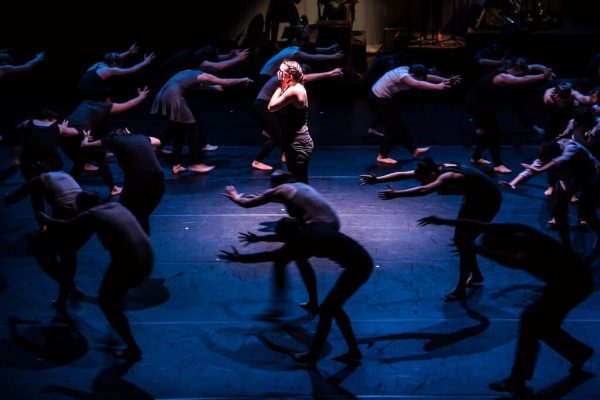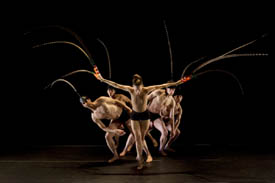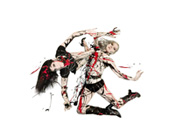Grace, it would appear, is a rich state of being. According to the traditional hymn, “Amazing Grace”, “‘Twas grace that taught my heart to fear/And grace my fears relieved&.” We say grace before a meal to show thankfulness. The ability to move gracefully is an important skill for a dancer.
“Grace” is also the title of the collaboration between Joe Laughlin and jamie griffiths. Laughlin is well known as a choreographer, dancer and the artistic director of Joe Ink, and for the community dance creation workshop he runs in the summer. Photographer griffiths exhibits her work in galleries and also directs experimental films. According to the duo’s promotional material, their “Grace” is “an interactive cutting-edge dance performance event&.”
For the most part, Laughlin and griffiths’ “New Media Duet” takes place between a large screen at the back of the stage and a transparent scrim across the front, both of which have images projected onto them. The front one pretty well disappears when not being used for projections, although it is still there, providing a distancing, not-quite-invisible barrier between spectator and performers.
The concept behind “Grace” arises from the computer program used by griffiths. The program creates images by picking up light through a camera, which is the computer system’s “eyes”. In this case, it is picking up the light reflected from Laughlin’s body, and the light is meant to “become a metaphor for life”. The costume design by Lip Service and Nancy Smith has The Dancer, Laughlin, all in white — from jacket and short, pleated skirt to socks and runners– in order to ensure as much light from his body as possible.
Rather than philosophical ideas about light and life, it is the paraphernalia of computers and cameras, the work’s much touted “creative edge of interactive performance technology”, that seems the real raison d’être for “Grace”. The interactive stage space in which Laughlin can trigger visual images is definitely cool. The technical know-how that lets him juggle a ball that exists only on the back screen, or play with the appearance and disappearance of his projected image, provides excellent special effects. But these bits of wizardry, though fabulous in and of themselves, are not enough to give coherence and meaning to the hour-long performance.
Certainly, technology contributes less to the choreographic enterprise than it does to the complexity of griffith’s computer-generated, real time, projected images. She is on stage as The Visualist, costumed like a character from Star Trek in a fitted, white lab coat, silver leggings and running shoes, with eccentrically styled hair arranged in a bottle-blonde spray at the very top of her head.
Many of griffiths’ images, which she improvises each night, are impressive enough to be exhibited on their own. They are made with intriguing layers of geometric shapes and visual noise, or show Laughlin’s body recreated in glowing mauve and green or in gritty, grainy black and white.
Despite having the intellectual ability to set up and run complicated electronic equipment, The Visualist is naïve enough to believe, as a program note informs us, that she can find “the source of humanity within The Dancer’s body&.” She attempts to do this by putting him in her “rolling technology Lab” and letting him dance a little, then probing him with her techno toys. We are, it would appear, in mad scientist territory.
Although Laughlin is on stage throughout, there is a limited amount of choreography in “Grace”. At one point, the gentle, spacey sounds of Leonard J. Paul’s original score give way to a disco beat and that’s when Laughlin gets to really move. His professional training in ballet and modern dance, along with his gymnastics background, are combined with a cool, edgy style. Laughlin steps quickly and cleanly, and falls and recovers with real finesse. In this too-brief section, even in full collapse Laughlin is a dancer full of grace & but then the technology asserts itself yet again and griffiths sticks her camera up against his head to get more close-up images. The new media are really having their own party, to which the choreographer’s contribution is almost incidental. Too often, when Laughlin is dancing, the large computer images draw the eye away from the small human figure.
The Visualist calls the shots, however crazy, and The Dancer is mere fodder for her experiments. In the final section, she pans her camera over his prone, naked body. He appears to be dead, having staggered to the edge of the performing space in front of the scrim, dragging himself centre stage and collapsing. The Visualist manipulates his body: she plays with his hands and feet, and opens his mouth and thrusts her camera into it. As always, the created images are fascinating — the puffy little circles made by the tops of his toes, for instance, are delightful — but it is a sad finale for The Dancer.
And where does it leave us in terms of answering the question, “Am I Divine?” which is posed by the artists in their publicity, and is apparently under investigation in “Grace”? A human silhouette made with light is projected onto the scrim to end the piece, but it does not convincingly emanate from the lifeless Dancer. It is, once more, just The Visualist doing her thing with the computer program.
Tagged: Contemporary, New Media, Performance, BC




